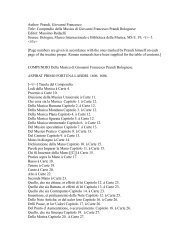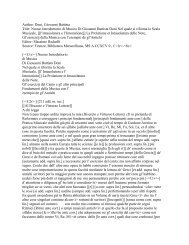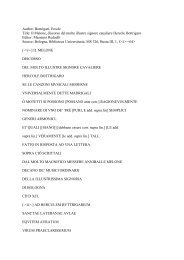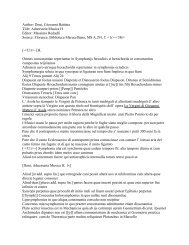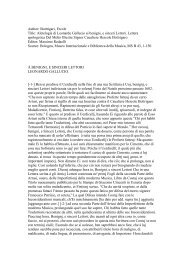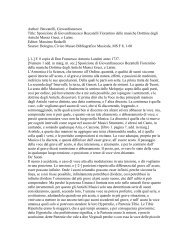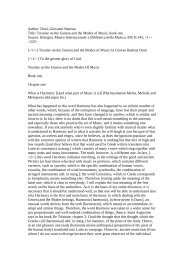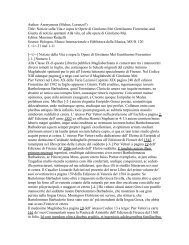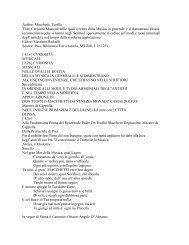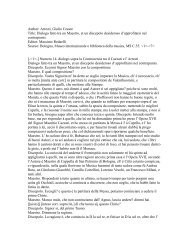Author: Dentice, Luigi - manuscripts of italian music theory in ...
Author: Dentice, Luigi - manuscripts of italian music theory in ...
Author: Dentice, Luigi - manuscripts of italian music theory in ...
Create successful ePaper yourself
Turn your PDF publications into a flip-book with our unique Google optimized e-Paper software.
and <strong>of</strong> three <strong>in</strong>tervals because the first one is re, mi, fa, sol, the second one is mi, fa, sol,<br />
la and the third one is ut, re, mi, fa, and it cannot have more than three <strong>in</strong>tervals. It<br />
consists <strong>of</strong> two tones [-f.15r-] and a semitone, as you can see, because re, mi is a tone; mi,<br />
fa is a m<strong>in</strong>or semitone and fa, sol is another tone. The same occurs <strong>in</strong> the other <strong>in</strong>tervals,<br />
so that you will aalways f<strong>in</strong>d the m<strong>in</strong>or semitone <strong>in</strong> the last position, <strong>in</strong> the middle one or<br />
<strong>in</strong> the first one. Ut, re, mi, fa has it <strong>in</strong> the last place, re, mi, fa, sol <strong>in</strong> the middle one and<br />
mi, fa, sol, la <strong>in</strong> the first one. The consonance <strong>of</strong> the diapente consists <strong>of</strong> five notes and<br />
four <strong>in</strong>tervals and <strong>of</strong> three tones and a m<strong>in</strong>or semitone. The consonance <strong>of</strong> the diapason<br />
consists <strong>of</strong> five tones and two m<strong>in</strong>or semitones, which do not complete a tone, s<strong>in</strong>ce it has<br />
been already demonstrated that the diapason consists <strong>of</strong> the diapente and the diatessaron,<br />
the diatessaron <strong>of</strong> two tones and a m<strong>in</strong>or semitone and the diapente <strong>of</strong> three tones and a<br />
m<strong>in</strong>or semitone. Therefore, all <strong>of</strong> these add up to five tones and two m<strong>in</strong>or semitones.<br />
However, s<strong>in</strong>ce each one <strong>of</strong> those two semitones is not entirely one half <strong>of</strong> the tone, added<br />
together they do not reach a full tone. Consequently, the diapason is composed <strong>of</strong> five<br />
tones and two m<strong>in</strong>or semitones, which, as they do not add up to a tone, they also exceed<br />
the entire semitone. Therefore, I did not say that the tone cannot be divided, but that it<br />
cannot be divided <strong>in</strong>to two equal parts <strong>in</strong> a way that serves our purpose. In fact, were the<br />
tone to be divided <strong>in</strong> the way described by Philolaus, the human voice would not be able<br />
to produce it.<br />
Serone. I am satisfied with this, but I would like to know the notes <strong>of</strong> the Cithara, their<br />
names, how their number was <strong>in</strong>creased and how they acquired their name.<br />
Soardo. I shall give you some <strong>in</strong>formation about them. Nichomacus says that <strong>music</strong> <strong>in</strong> the<br />
beg<strong>in</strong>n<strong>in</strong>g was simple, as it consisted <strong>of</strong> four str<strong>in</strong>gs tuned to four notes. This lasted up to<br />
Orpheus. The str<strong>in</strong>gs were tuned <strong>in</strong> such a way that the first one and the last one sounded<br />
the diapason, and the middle str<strong>in</strong>gs respectively sounded with the ones at the diapente,<br />
the diatessaron and the tone, so that there was no dissonance among them, <strong>in</strong> imitation <strong>of</strong><br />
the <strong>music</strong> <strong>of</strong> the cosmos, which consists <strong>of</strong> four elements<br />
ad imitatione della <strong>music</strong>a mondana, la quale consta di quattro elementi, which form a<br />
tetrachord said to have been <strong>in</strong>vented by Mercurius. The fifth str<strong>in</strong>g was added to the<br />
others [-f.15-] by Corebus son <strong>of</strong> Atys, who was k<strong>in</strong>g <strong>of</strong> the Phrygians, while the<br />
Phrygian Hyagnis discovered the sixth one and Terpander <strong>of</strong> Lesbos added the seventh.<br />
The lowest <strong>of</strong> these str<strong>in</strong>gs was called Hypate, as if it were the most important and worthy<br />
<strong>of</strong> greater respect, and this is why Jove is called hypaton and the consuls because <strong>of</strong> the<br />
importance <strong>of</strong> their status. This str<strong>in</strong>g it is also ascribed to Saturn because <strong>of</strong> its slow<br />
motion and depth <strong>of</strong> sound. The second one was called parhypate because it is placed and<br />
located next to the hypate and it is ascribed to Jove. The third was called lichanos and it<br />
derives its name from the f<strong>in</strong>ger that we call <strong>in</strong>dex and that the Greeks call lichanos, and<br />
also because it was the <strong>in</strong>dex f<strong>in</strong>ger that struck and plucked said third str<strong>in</strong>g, so it was<br />
called lichanos and ascribed to Mars. The fourth one is called mese because it is always<br />
placed <strong>in</strong> the middle <strong>of</strong> those seven str<strong>in</strong>gs and it is ascribed to the sun. The fifth is called<br />
paramese, as to mean 'next to the mese' and it is ascribed to Mercury. The sixth is called<br />
paranete because it is next to the nete and it is dedicated to Mercury and the seventh is<br />
called nete, from the term neato which means <strong>in</strong>ferior, although Cicero lays out a different<br />
sequence and says that nature ordered it <strong>in</strong> such a way that the extremities sound low at<br />
one end a and high at the other. For this reason, the highest sphere <strong>of</strong> the stars which<br />
procedes with the greatest speed moves produc<strong>in</strong>g a high-pitched and <strong>in</strong>tense sound,<br />
while the sphere <strong>of</strong> the Moon, which is the lowest, produces the lowest sound, s<strong>in</strong>ce, as<br />
the earth is immobile, it occupies always the same position and it assigned to silence, so<br />
that the lowest position is given to the moon, which corresponds to the<br />
proslambanomenos, while Mercury is related to the hypate hypaton, the Sun to the



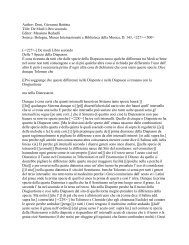
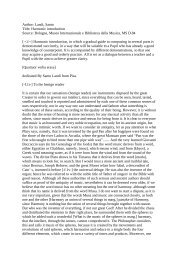
![Doni, Giovanni Battista Title: Trattato Dei Tuoni o [[Harmonie de]]](https://img.yumpu.com/45461005/1/190x245/doni-giovanni-battista-title-trattato-dei-tuoni-o-harmonie-de.jpg?quality=85)
